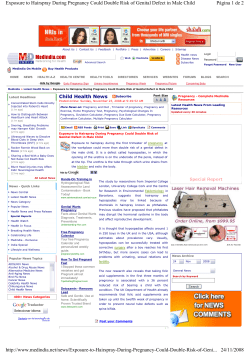
Pregnancy and CKD Sheena Surindran MD Grand Rounds 1/18/11
Pregnancy and CKD Sheena Surindran MD Grand Rounds 1/18/11 • • • • Physiologic changes during normal pregnancy Effect of ckd on pregnancy Outcomes of pregnancy in ckd Pregnancy and dialysis • Changes in tubular function • Uric acid excretion • Increased protein excretion‐ upto 300mg/day. p/cr ratio not recommended. • Chronic respiratory alkalosis‐ due to increased levels of progestrone which stimulates medullary resp centers‐ kidneys in response will excrete more bicarbonate. Physiologic changes during pregnancy • Both kidneys increase in size by 1‐1.5cm • Dilatation of ureters and renal pelvis esp on right side occurs in 80% of women • Increase in renal vascular and interstitial volume by 30% • Increase in GFR • hormone relaxin thought to play imp role • Decrease osmolality‐ decreased threshold for AVP release and thirst. A new set point achieved. (287 mosm vs 298 ) Increased GFR/RBF Increases by 50% by end of 1st trimester Filtered load of sodium and water increases Increase tubular reabsorptive capacity Normal pregnancy accumulation of 900mmol of sodium • Animal study in pregnant and non pregnant sheep under basal and salt loaded conditions • • • • Am. J. of Physiology 265:F278‐284,1993 MAP/RBF/GFR/FPTR Sodium and water excretion Effect of saline load on FDRNa Conclusions • Both renal blood flow and gfr increase in pregnancy making the filtration fraction constant. • Proximal and distal tubular reabsorption as measured by lithium clearance was increased but the fractional prox tubular reabsorption was unchanged. Kidney international, Vol. 18 (1980), pp. 152 ‐161 Kidney international, Vol. 18 (1980), pp. 152 ‐161 Tubular function Renal handling of uric acid • Reduction in serum uric acid levels sec to increased gfr esp in early pregnancy • Degree of uricemia seem to correlate with severity of preeclampsia‐ there is net increased reabsorption • Random values of uric acid level not helpful but a serial trend may be help differentiate between preeclampsia and other hypertensive states Kidney international, Vol. 18 (1980), pp. 152 ‐161 Plasma uric acid in pregnancy Renal handling of glucose • Increase glucose excretion in normal pregnancy which peaks at 8‐11weeks • More pronounced in women with lower height and body weight • ( Eur J Obstet Gynecol Reprod Biol. 2010 Jun;150(2):132‐6. Epub 2010 Mar 5) Kidney international, Vol. 18 (1980), pp. 152 ‐161 Fractional excretion of glucose Effect of pregnancy on kidney disease Increase in Proteinuria Worsening of hypertension Increased risk of preeclampsia Worsening of renal function‐ temporary vs permanent • Worsening of anemia • • • • Effect of kidney disease on pregnancy • Degree of renal failure determines outcome rather than underlying disease. • Absence of hypertension significantly decreases chance of irreversible outcomes • Inability to ACE / ARB in pregnancy‐ enalapril can be used safely during breast feeding. Pregnancy outcomes in stage 3‐5 longitudinal multicenter cohort study Non diabetic Caucasian women >20wks pregnant Gfr<60 ml/min Primary outcome‐ rate of decrease in gfr before preg and after, maternal/ fetal outcome, LBW • Conclusion‐ Both the presence of gfr<40 and proteinuria >1gm predicts poor maternal and fetal outcomes • • • • Am J Kidney Dis 49:753‐762. © 2007 by the National Kidney Foundation Am J Kidney Dis 49:753‐762. © 2007 Am J Kidney Dis 49:753‐762. © 2007 Kidney disease an independent risk factor for maternal/ fetal outcomes • Colorado birth and death certificate from 1989‐ 2001 • 911 births from women with kidney disease and 4606 births from women without kidney ds • Women with kidney ds had adverse fetal (18.2% vs 9.5%) and maternal (13.7% vs 4.3%) outcomes – p<0.001. this is independent of other risk factors. American Journal of Kidney Diseases, Vol 43, No 3 (March), 2004 Outcomes in mod‐severe CKD • • • • • • • 82 pregnancies in 67 women between 1971‐93 Serum creat – 1.4‐2.4‐ moderate‐, >2.5 severe‐ Pregnancy sustained > 1st trimester included 43% pts had pregnancy related loss in renal fn 10% had rapid decline in renal fucntion Preterm delivery in 60% Infant survival rate 93% N Engl J Med 1996;335:226‐32 Study characteristics N Engl J Med 1996;335:226‐32 N Engl J Med 1996;335:226‐32 N Engl J Med 1996;335:226‐32 GFR during Pregnancy N Engl J Med 1996;335:226‐32 GFR post pregnancy N Engl J Med 1996;335:226‐32 Pregnancy in dialysis‐ should we change our counseling? 1st reported successful pregnancy 40yrs ago Incidence is about 7% 40‐60% successful outcome, 85% infants premature Erythropoietin can be safely used in pregnancy Either modality can be chosen for RRT in preg General consensus is to increase duration of treatment to at least 20hrs/ week. • Consensus to maintain predialysis bun <30‐50 • Can use heparin (does not cross placenta) • May need both CAPD and CCPD in late preg • • • • • • Conclusions • Pregnancy in dialysis populations has improved outcomes compared to 40yrs ago‐ • Small for age gestational age still remains a major problem (75‐100%). • Risk of maternal death seems low though there is increased morbidity. Thank you
© Copyright 2025





















